Hi,
I wish to express my thanks to everyone who makes up this site. I just found it today, and appreciate the wealth of information I am finding here. The articles on typology were particularly helpful.
Could any of you express an opinion on the age and type of a sword I just purchased?
It is eBay #300297078349.
Any assistance would be appreciated.
Thank you,
Bill
Hi and welcome to the site.
Since this is a completed auction, we're allowed to freely discuss the item in question. I do, however, ask that you please post the information here with photos and specifics rather than asking our members to go elsewhere and search for it on eBay. People will be more likely to help you if you do the legwork for them.
To help you, I've attached some photos of your item and am including some info from the auction:
Closing cost: $810 US
Thank you.
My take: it's modern. It's certainly not Roman, but I find it doubtful that it's even 50 years old.
 Attachment: 12.99 KB
Attachment: 12.99 KB
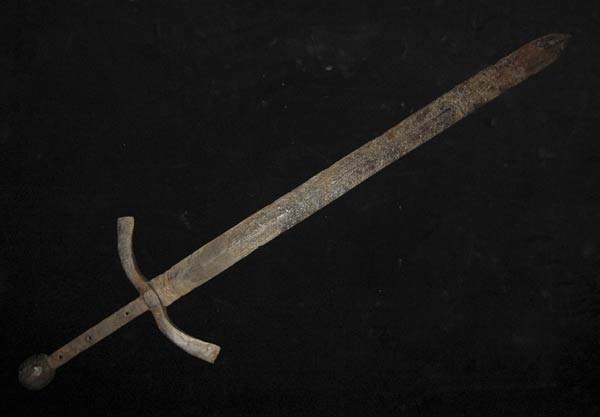
 Attachment: 19.97 KB
Attachment: 19.97 KB
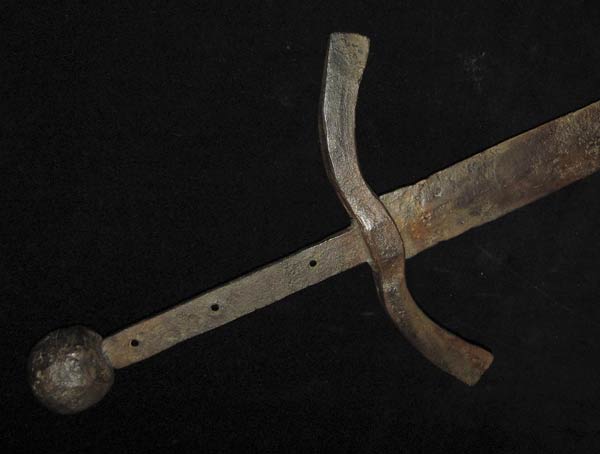
 Attachment: 31.29 KB
Attachment: 31.29 KB
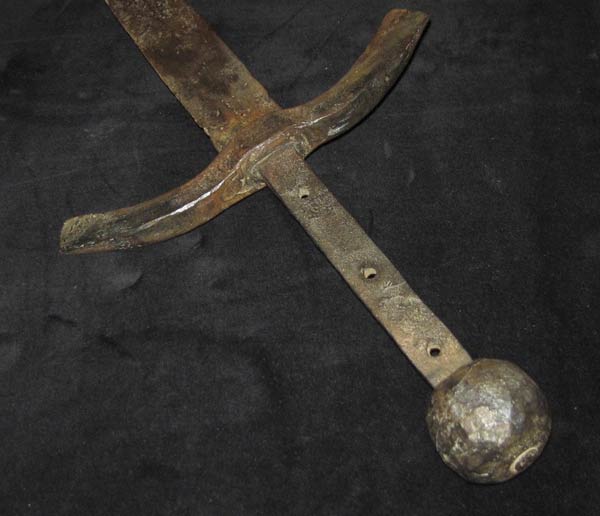
Since this is a completed auction, we're allowed to freely discuss the item in question. I do, however, ask that you please post the information here with photos and specifics rather than asking our members to go elsewhere and search for it on eBay. People will be more likely to help you if you do the legwork for them.
To help you, I've attached some photos of your item and am including some info from the auction:
Closing cost: $810 US
| Quote: |
| VERY ANTIQUE SWORD PERHAPS EVEN ROMAN
COMES FROM A HIGH CLASS PRIVATE COLECTION OF MAJORLY ARCHAEOLOGICAL FINDS COLECTOR ALREADY PASSED AWAY AND I CANNOT INQUIRE MORE DETAILED INFORMATION ON THAT PIECE ! IRON IS STILL QUITE STABILE ! TOTAL LENGTH 33 INCHES AT ABOUT 1,55 inches Width |
Thank you.
My take: it's modern. It's certainly not Roman, but I find it doubtful that it's even 50 years old.



Hi Bill,
can you give the complete link? I do not know which ebay, U.K. , U.S.A. or. what country.
First guess (without literature) , around 1500. May be a little bit younger, early 16th Century.
So please other opinions...
Sorry for bad englisch.
greetings
can you give the complete link? I do not know which ebay, U.K. , U.S.A. or. what country.
First guess (without literature) , around 1500. May be a little bit younger, early 16th Century.
So please other opinions...
Sorry for bad englisch.
greetings
| Nathan Robinson wrote: |
| My take: it's modern. It's certainly not Roman, but I find it doubtful that it's even 50 years old. |
I have to agree. The blade geometry is just... odd. Type XVIII? Type X sans fuller? What was it trying to be, exactly? The guard also seems far too bulky. And the pin holes in the tang don't sit quite right to me either, nor does the lack of any taper as the tang approaches the pommel (to say nothing of the retrograde taper in the blade itself). Is that peened? Peened and riveted?
I may be wrong, and this may be an exception that proves a big pile of rules, but I concur that it looks like a modern piece. Probably ground from bar stock and aged artificially. :confused:
From my intermediate layman's view, it looks like a modern replica as well. I seen one very similar recently that came from eBay that the buyer returned. There appear to be bad overpenetrating welds (arc-welded too hot resulting in the severe sculpting patterns near the bottom of guard) holding the guard to the tang and I believe that the riveted scales are out of place (as previously mentioned). :wtf:
I'd ask the seller for documentation on the piece, such as the auction appraisal, oritinal purchase paperwork that proves it came from an estate, or certification papers - if any of these exist.
Interesting to say the least. Definately worth getting a professional opinion on.
I'd ask the seller for documentation on the piece, such as the auction appraisal, oritinal purchase paperwork that proves it came from an estate, or certification papers - if any of these exist.
Interesting to say the least. Definately worth getting a professional opinion on.
The guard is not just bulky it was forged too cold. One can still see the stress of that in the surface of the metal. Which also means that it was never properly cleaned after production.
The tip of the blade also seems to be broader than the rest of the blade. That happens when you don't draw out the material properly when shaping the tip.
Furthermore the holes in the tang look drilled and not punched.
The tip of the blade also seems to be broader than the rest of the blade. That happens when you don't draw out the material properly when shaping the tip.
Furthermore the holes in the tang look drilled and not punched.
Cross is bulky, and very rough. Pommel is just a badly shaped spheroid object, tang is peened without intermediate ring. People who have seen real originals from the age this sword would like to be belonging will imemdiately notice teh difefrence with teh elaborate gentle shape of originals.
Also rust is reddish and there seems to be some forging scale on part of the surface.
This item has been left as it leaved the forge, since often scale and a rough surface may appear as ancient to untrained eyes.
I remember having shown a just smithed langsax to the rich owner of a small museum, it was covered with blackish scale andd some pitting out of too hot forging (I had worked in full light at a demo so I couldn't control temperature at all).
He immediately exclaimed that it was an authentic "sword" and that he wanted it. Had I been dishonest i would have made some good money just out of an iron piece as the man was really eager to buy it, despite his experience as a collector of old anvils and smithing tools.
So deliberate smithing errors can be exploited to create quickly fake pieces that appear attractive to average people.
Also rust is reddish and there seems to be some forging scale on part of the surface.
This item has been left as it leaved the forge, since often scale and a rough surface may appear as ancient to untrained eyes.
I remember having shown a just smithed langsax to the rich owner of a small museum, it was covered with blackish scale andd some pitting out of too hot forging (I had worked in full light at a demo so I couldn't control temperature at all).
He immediately exclaimed that it was an authentic "sword" and that he wanted it. Had I been dishonest i would have made some good money just out of an iron piece as the man was really eager to buy it, despite his experience as a collector of old anvils and smithing tools.
So deliberate smithing errors can be exploited to create quickly fake pieces that appear attractive to average people.
Hi Guys,
I want to thank you all for your comments, this helps alot.
I felt that it was a XIII without a fuller. The round ball pommel seems to me to be a type R, and since this was most common during an early period, I figured there was justification for the crudity of the work. I figured the cross style was a type 6, which would make it 13th C,possibly. I am including some pictures of a 14th C German blade from the MET.
You will note that it has a round ball pommel, that the tang hardly narrows at all, and that it has no fuller.
As for the tang holes, I believe that if you look closely at the center hole, you will see that the metal surface is raised around the hole. Which is an indication to me that it was punched, not drilled.
Of course, I want this to be a good piece, so all of this may be wishfull thinking on my part.
Thank you all for your help,
Bill
 Attachment: 110.41 KB
Attachment: 110.41 KB
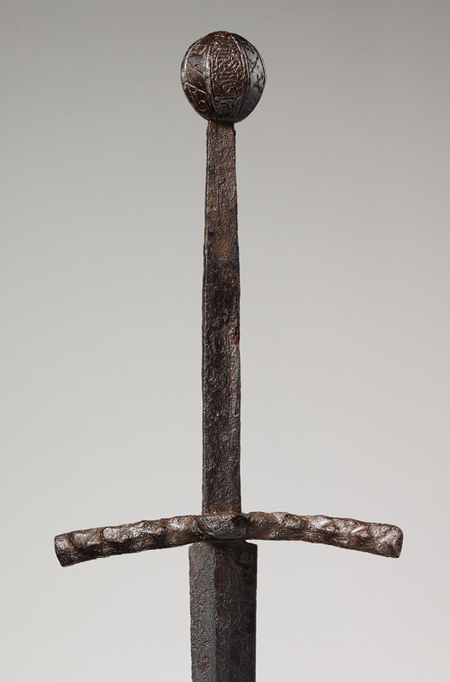
 Attachment: 11.79 KB
Attachment: 11.79 KB

 Attachment: 114.24 KB
Attachment: 114.24 KB
[ Download ]
 Attachment: 117 KB
Attachment: 117 KB
[ Download ]
I want to thank you all for your comments, this helps alot.
I felt that it was a XIII without a fuller. The round ball pommel seems to me to be a type R, and since this was most common during an early period, I figured there was justification for the crudity of the work. I figured the cross style was a type 6, which would make it 13th C,possibly. I am including some pictures of a 14th C German blade from the MET.
You will note that it has a round ball pommel, that the tang hardly narrows at all, and that it has no fuller.
As for the tang holes, I believe that if you look closely at the center hole, you will see that the metal surface is raised around the hole. Which is an indication to me that it was punched, not drilled.
Of course, I want this to be a good piece, so all of this may be wishfull thinking on my part.
Thank you all for your help,
Bill


[ Download ]
[ Download ]
This MET sword is really a nice one.
About the crudity of the first sword... It means nothing. From celtic times to late medieval very fine weapons were made.
About the crudity of the first sword... It means nothing. From celtic times to late medieval very fine weapons were made.
Beware of misspellings (no matter the seller's nationality) vagueness and deceased former owners. Although the semi-literate English description is suggestive, it isn't explicit. Everything the seller wrote could be true and the piece could still be 50 or 100 years old. It certainly could be Roman. It could also be Milanese, Toledan, Kievan, San Franciscan or Onalaskan. The seller didn't say it could be ancient Roman.
What does "very antique" mean? I have some very antique books by George Orwell, printed in the 1940s.
As for provenance--the best museums in the world contain forgeries and reproductions, and many a local museum or private collection contains misidentified and forged items. I know of one prominent city museum that accepted a private arms collection and apparently relied on the previous owner's identifications, resulting in some badly mis-dated pieces, not to mention a pack rat's thematic discrimination.
Notice that the seller is located in Graz, Austria, home of one of the world's greatest arms and armour collections. It would be a very simple matter for the seller to have the Landezeughaus folks authenticate the piece, which could add thousands of dollars to the auction price. Why would the seller not go to that trouble?
The price is another clue. When an auction item resembles an important published example or something in a major museum collection, but sells for $850.....
See Hermann Historica's site to get a sense of what authentic medieval swords in this condition bring at auction. When you see something there at this price and in this condition, notice the first words of the German description--"Historismus" or "im Stil," which are polite ways of saying "forgery" or "reproduction".
My guess would be that this is a late 19th or early 20th century theatrical prop or decorative piece, either naturally or artificially aged. I'm not an expert and I could be wrong.
None of this is meant to suggest that the seller is dishonest. He could be acting 100 percent in good faith. But I'll eat my hat if somebody proves to me that this sword is more than 150 years old.
What does "very antique" mean? I have some very antique books by George Orwell, printed in the 1940s.
As for provenance--the best museums in the world contain forgeries and reproductions, and many a local museum or private collection contains misidentified and forged items. I know of one prominent city museum that accepted a private arms collection and apparently relied on the previous owner's identifications, resulting in some badly mis-dated pieces, not to mention a pack rat's thematic discrimination.
Notice that the seller is located in Graz, Austria, home of one of the world's greatest arms and armour collections. It would be a very simple matter for the seller to have the Landezeughaus folks authenticate the piece, which could add thousands of dollars to the auction price. Why would the seller not go to that trouble?
The price is another clue. When an auction item resembles an important published example or something in a major museum collection, but sells for $850.....
See Hermann Historica's site to get a sense of what authentic medieval swords in this condition bring at auction. When you see something there at this price and in this condition, notice the first words of the German description--"Historismus" or "im Stil," which are polite ways of saying "forgery" or "reproduction".
My guess would be that this is a late 19th or early 20th century theatrical prop or decorative piece, either naturally or artificially aged. I'm not an expert and I could be wrong.
None of this is meant to suggest that the seller is dishonest. He could be acting 100 percent in good faith. But I'll eat my hat if somebody proves to me that this sword is more than 150 years old.
Last edited by Sean Flynt on Tue 10 Mar, 2009 2:09 pm; edited 1 time in total
Now at home with a better screen, I see again: photos can be deceiving. :eek: The crossguard ist really bulky…
From photo, I can not see if the wholes in the tang are punched or drilled.
But in all postings were good hints : about the sword itself
- and about the way to offer a sword or no authentic sword!
Only for completing:
Without holding it in hands, it is always difficult to loose doubts.
During the times there were made “good” and “ bad” weapons (Quality), of course
Desire often makes blind
Special wish to Arne Focke. You wrote:
“The guard is not just bulky it was forged too cold. One can still see the stress of that in the surface of the metal. Which also means that it was never properly cleaned after production.
The tip of the blade also seems to be broader than the rest of the blade. That happens when you don't draw out the material properly when shaping the tip.”
Would be glad about detailed declaration, preferred in german. Because my englisch is rusty like that sword.
From photo, I can not see if the wholes in the tang are punched or drilled.
But in all postings were good hints : about the sword itself
- and about the way to offer a sword or no authentic sword!
Only for completing:
Without holding it in hands, it is always difficult to loose doubts.
During the times there were made “good” and “ bad” weapons (Quality), of course
Desire often makes blind
Special wish to Arne Focke. You wrote:
“The guard is not just bulky it was forged too cold. One can still see the stress of that in the surface of the metal. Which also means that it was never properly cleaned after production.
The tip of the blade also seems to be broader than the rest of the blade. That happens when you don't draw out the material properly when shaping the tip.”
Would be glad about detailed declaration, preferred in german. Because my englisch is rusty like that sword.
I'll send you a PM in a moment, since all that German won't be of any use for most of the community. ;)
I am by no means an expert on ancient swords but my first thought was that it looked like a rusty version of my Starfire bastard sword (think its now listed as a 1 meter 2 handed sword on there site) except someone bent the cross guard up over an anvil. I wish I could have found some better pictures of the cross guard and blade than what is shown on there site.
Edit:
The more I look at the pictures the more I want to get home and take the wrapping off the grip of my SLO to see if it has the three holes seen in the picture.
Edit:
The more I look at the pictures the more I want to get home and take the wrapping off the grip of my SLO to see if it has the three holes seen in the picture.
Thanks Sean,
Hermann's was a big help.
I'll post a couple of photos from there.
Bill
 Attachment: 15.63 KB
Attachment: 15.63 KB
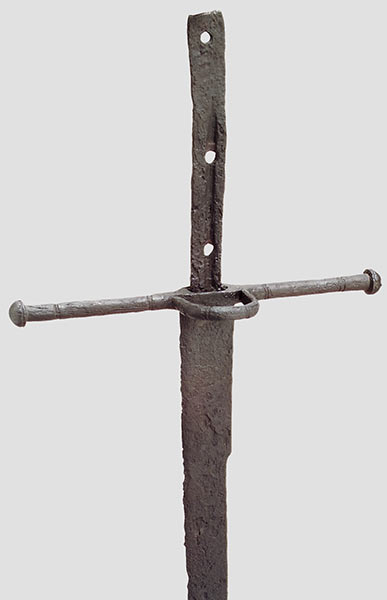
Hermann's was a big help.
I'll post a couple of photos from there.
Bill

How about this one?
 Attachment: 16.08 KB
Attachment: 16.08 KB
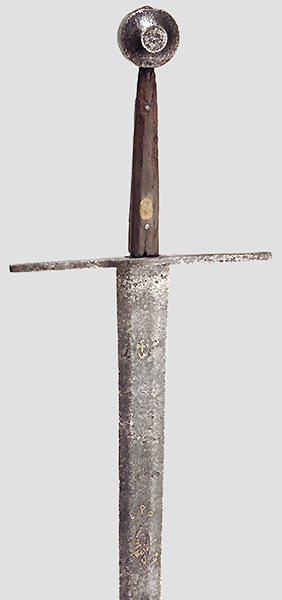

Or this, showing a crude rounded pommel?
 Attachment: 10.97 KB
Attachment: 10.97 KB


Bill, i think most of us are aware of antique swords with spherical pommels and holes in the tang. I don't believe it would sway any of the opinions expressed thus far, however. It certainly does not change mine.
I agree with Nathan on that.
There are similarities between the pictures, but just very slightly.
The swords you just posted are of better quality and way more rusted than the sword in question, which is barely rusted at all.
What looks like rust is just hammer marks and slag from the forging.
The only time i've seen swords like that where during forging classes in our museums forge, done by absolut beginners.
Sorry, but that is my opinion on that piece and a rather firm opinion it is.
There are similarities between the pictures, but just very slightly.
The swords you just posted are of better quality and way more rusted than the sword in question, which is barely rusted at all.
What looks like rust is just hammer marks and slag from the forging.
The only time i've seen swords like that where during forging classes in our museums forge, done by absolut beginners.
Sorry, but that is my opinion on that piece and a rather firm opinion it is.
Hi Bill,
Sorry to say I agree with others on this thread. Bear in mind that developing a feel for this takes a while and doesn't always come down to a checklist of obvious features - sometimes things like the color and nature of oxidation is enough to ring alarm bells. To my eye, the other photos posted here are all of authentic swords, whereas this eBay item simply does not inspire confidence (actually, to be completely honest I would have said "total fake").
Personally speaking, I generally avoid eBay even with much better descriptions and more promising photos. I have simply seen too many instances of poor items being pushed through that system than anywhere else - it is emphatically not a good market for beginners.
I am sorry to add to any disappointment you may be feeling, but sometimes we have to "pay our dues" so to speak in acquiring an education on telling authentic from inauthentic. I hope that you stick around and continue to learn about and enjoy historical arms & armour,
Regards,
Gabriel L.
Sorry to say I agree with others on this thread. Bear in mind that developing a feel for this takes a while and doesn't always come down to a checklist of obvious features - sometimes things like the color and nature of oxidation is enough to ring alarm bells. To my eye, the other photos posted here are all of authentic swords, whereas this eBay item simply does not inspire confidence (actually, to be completely honest I would have said "total fake").
Personally speaking, I generally avoid eBay even with much better descriptions and more promising photos. I have simply seen too many instances of poor items being pushed through that system than anywhere else - it is emphatically not a good market for beginners.
I am sorry to add to any disappointment you may be feeling, but sometimes we have to "pay our dues" so to speak in acquiring an education on telling authentic from inauthentic. I hope that you stick around and continue to learn about and enjoy historical arms & armour,
Regards,
Gabriel L.
Riveted grip construction is historical, but primarily in the context of the messer (the first HH image above) That weapon typically does not have a sword pommel. Rather, it has a relatively small iron cap, flat plate or thick block whose form merges with the scales of the grip. You'll also notice that tangs with rivet holes tend to be broader than the typical sword tang because messer tangs are the full width of the grip, with the edges of the tang exposed between the wooden scales (unless the whole grip is then covered with leather, which was sometimes the case, apparently). The second HH image above is a bit of an outlier. The shiny rivets look like a modern addition, but the construction and wood could be original. Some swords had scale grips like this (not usually riveted,) but would have been covered with leather and possibly bound with cord.
The rivet holes of your sword are what make me think that this was a theatrical piece. Whereas few know how to make a proper sword grip, lots of folks know how to make knife grips, and if you wanted a stout theatrical prop, this would be a relatively simple and quick way to make the grip. In fact, a modern knife cutler's first instinct would probably be to make a sword grip this way. But if you wanted to create a forgery, this is a pretty glaring error that actually cost the forger more time than if he had left the tang un-pierced.
The rivet holes of your sword are what make me think that this was a theatrical piece. Whereas few know how to make a proper sword grip, lots of folks know how to make knife grips, and if you wanted a stout theatrical prop, this would be a relatively simple and quick way to make the grip. In fact, a modern knife cutler's first instinct would probably be to make a sword grip this way. But if you wanted to create a forgery, this is a pretty glaring error that actually cost the forger more time than if he had left the tang un-pierced.
Page 1 of 2
You cannot post new topics in this forumYou cannot reply to topics in this forum
You cannot edit your posts in this forum
You cannot delete your posts in this forum
You cannot vote in polls in this forum
You cannot attach files in this forum
You can download files in this forum
All contents © Copyright 2003-2006 myArmoury.com — All rights reserved
Discussion forums powered by phpBB © The phpBB Group
Switch to the Full-featured Version of the forum
Discussion forums powered by phpBB © The phpBB Group
Switch to the Full-featured Version of the forum